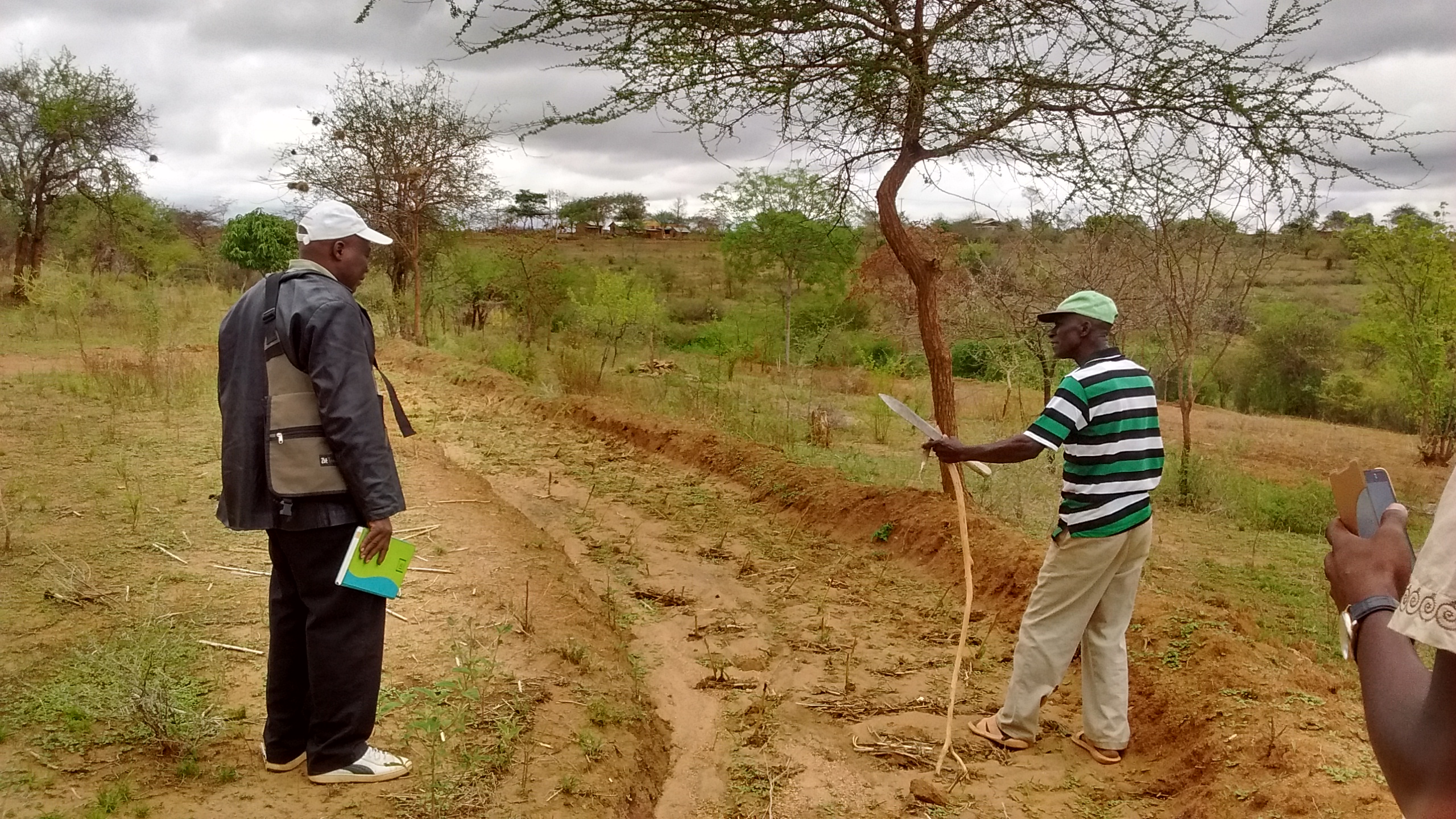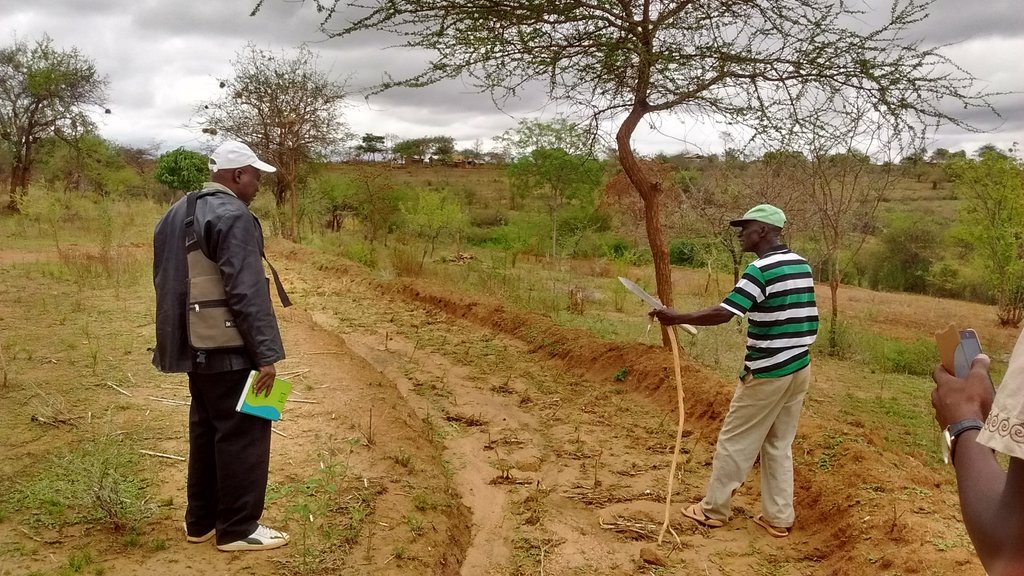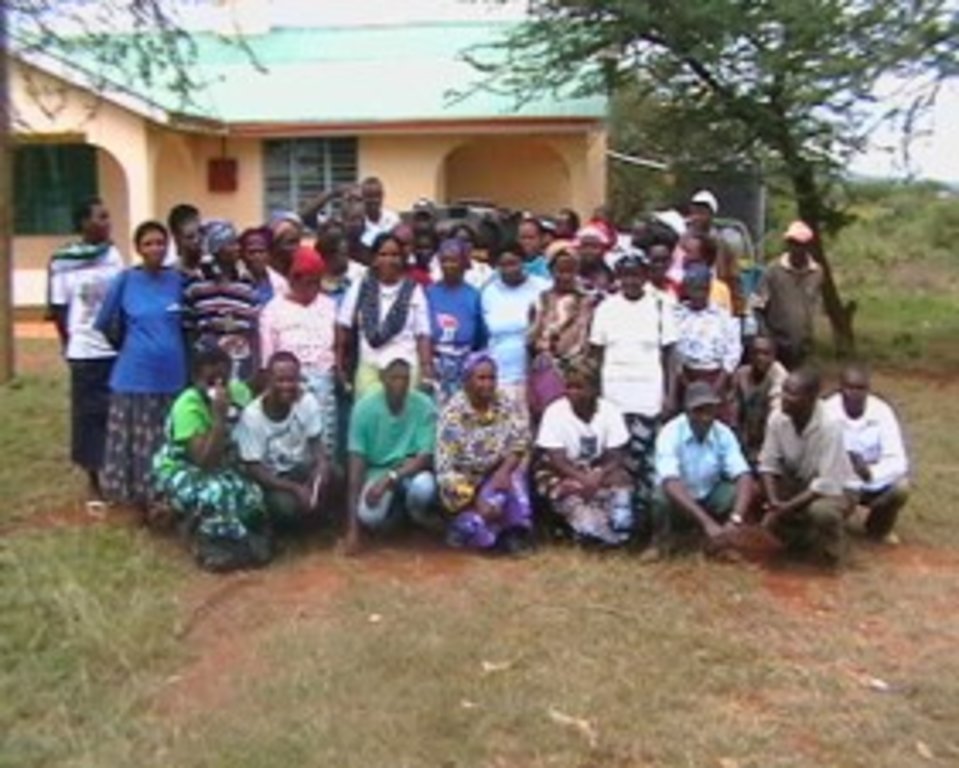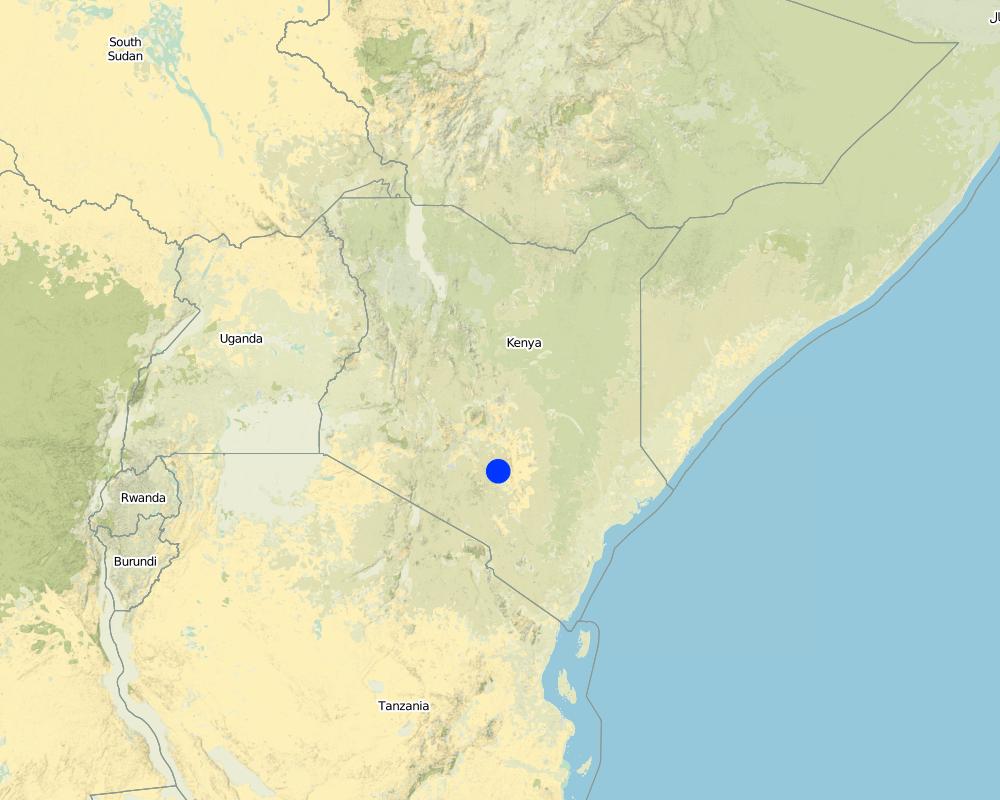On-farm indigenous pasture establishment demonstrations [ប្រទេសកេនយ៉ា]
- ការបង្កើត៖
- បច្ចុប្បន្នភាព
- អ្នកចងក្រង៖ Kevin Mganga
- អ្នកកែសម្រួល៖ –
- អ្នកត្រួតពិនិត្យ Rima Mekdaschi Studer
On-farm demos
approaches_3285 - ប្រទេសកេនយ៉ា
- សង្ខេបជា PDF
- សេចក្តីសង្ខេបពេញលេញជាទម្រង់ PDF សម្រាប់បោះពុម្ព
- សេចក្តីសង្ខេបពេញលេញទម្រង់អ៊ីនធឺនេត
- សេចក្តីសង្ខេបពេញលេញ (មិនមានទម្រង់ជាក់លាក់)
- In-situ pasture establishment demonstrations: 26 ខែ មករា ឆ្នាំ 2018 (inactive)
- On-farm pasture establishment demonstrations : 21 ខែ កុម្ភៈ ឆ្នាំ 2018 (inactive)
- On-farm indigenous pasture establishment demonstrations : 20 ខែ មេសា ឆ្នាំ 2018 (inactive)
- On-farm indigenous pasture establishment demonstrations : 3 ខែ កញ្ញា ឆ្នាំ 2018 (public)
ពិនិត្យមើលគ្រប់ផ្នែក
ពង្រីកមើលទាំងអស់ បង្រួមទាំងអស់1. ព័ត៌មានទូទៅ
1.2 ព័ត៌មានលម្អិតពីបុគ្គលសំខាន់ៗ និងស្ថាប័នដែលចូលរួមក្នុងការវាយតម្លៃ និងចងក្រងឯកសារនៃវិធីសាស្ត្រផ្សព្វផ្សាយ
បុគ្គលសំខាន់ម្នាក់ (ច្រើននាក់)
អ្នកជំនាញឯកទេស SLM:
ឈ្មោះគម្រោងដែលបានចងក្រងឯកសារ/ វាយតម្លៃលើវិធីសាស្ត្រផ្សព្វផ្សាយ (បើទាក់ទង)
Book project: Guidelines to Rangeland Management in Sub-Saharan Africa (Rangeland Management)ឈ្មោះអង្គភាពមួយ (ច្រើន) ដែលបានចងក្រងឯកសារ/ វាយតម្លៃលើវិធីសាស្ត្រផ្សព្វផ្សាយ (បើទាក់ទង)
Department of Range and Wildlife Sciences, South Eastern Kenya University (SEKU) - ប្រទេសកេនយ៉ា1.3 លក្ខខណ្ឌទាក់ទងទៅនឹងការប្រើប្រាស់ទិន្នន័យដែលបានចងក្រងតាមរយៈវ៉ូខេត
តើពេលណាដែលទិន្នន័យបានចងក្រង (នៅទីវាល)?
10/11/2017
អ្នកចងក្រង និង(បុគ្គលសំខាន់ៗ)យល់ព្រមទទួលយកនូវលក្ខខណ្ឌនានាទាក់ទងទៅនឹងការប្រើប្រាស់ទិន្នន័យដែលបានចងក្រងតាមរយៈ វ៉ូខេត:
បាទ/ចា៎
1.4 ការយោងមួយ (ច្រើន) ទៅលើ (កម្រង) បញ្ជីសំណួរនៃបច្ចេកទេស SLM
2. ការពណ៌នាអំពីវិធីសាស្ត្រផ្សព្វផ្សាយ SLM
2.1 ពណ៌នាសង្ខេបខ្លីពីវិធីសាស្ត្រផ្សព្វផ្សាយ
On-farm indigenous pasture establishment demonstrations offer a practical approach to encourage adoption in the arid and semi-arid environments in Kenya.
2.2 ពណ៌នាលម្អិតពិវិធីសាស្ត្រផ្សព្វផ្សាយ
ពណ៌នាលម្អិតពិវិធីសាស្ត្រផ្សព្វផ្សាយ:
The characteristic feature of the demonstration approach is the interaction of different stakeholders in on-farm showcasing of sustainable land management technologies. The stakeholders include land users, NGOs, SLM specialists, local government officials and university researchers. SLM specialists and university researchers, with the help of local government and NGO field officers demonstrate the entire process of grass reseeding from site selection, seedbed preparation, grass species selection, weeding, monitoring and evaluation of both plant and soil parameters. The method comprises on-farm demonstrations both at individual, and pastoral and agropastoral group sites, and a model demonstration site within the university premises. The role of the main stakeholders involved in the process are sharing the knowledge, skills and technology (the SLM specialists; researchers from the university), linking the SLM specialists with the pastoral communities, sharing their experiences through on-farm demonstrations and explanations of similar technologies local government (county officials), sharing knowledge of past experiences and skills (local NGOs). The end users of the technologies, namely the pastoral communities share their indigenous technical knowledge related to natural resource management. In this case study the end-users comprised approximately 40 livestock keepers. Over five visits and through the demonstrations, they liked the approach because it was more practical being on-farm (“seeing is believing”). It was appreciated as being easily replicated on their own land under the same local conditions of climate, soil type, grass species, methods of land preparation, and land use system. After interacting with the SLM specialists from the universities during the visits and on-farm demonstrations, land-users have adopted the technology to ensure a continuous supply of pasture for their livestock.
2.3 រូបភាពនៃវិធីសាស្ត្រផ្សព្វផ្សាយ
កំណត់សំគាល់ទូទៅរបស់រូបថត:
Stakeholders discussing and sharing their knowledge and skills.
2.5 ប្រទេស/តំបន់/ទីតាំងកន្លែង ដែលវិធីសាស្ត្រផ្សព្វផ្សាយត្រូវបានអនុវត្តន៍
ប្រទេស:
ប្រទេសកេនយ៉ា
តំបន់/រដ្ឋ/ខេត្ត:
Eastern Province
បញ្ជាក់បន្ថែមពីលក្ខណៈនៃទីតាំង:
Kitui municipality, Kitui county
Map
×2.6 កាលបរិច្ឆេទនៃការចាប់ផ្តើម និងបញ្ចប់នៃវិធីសាស្រ្តផ្សព្វផ្សាយនេះ
ប្រសិនអត់ចាំឆ្នាំ សូមចង្អុលបង្ហាញកាលបរិច្ឆេទប្រហែលៗពេលដែលវិធីសាស្ត្រផ្សព្វផ្សាយត្រូវបានចាប់ផ្តើមប្រើ:
តិចជាង 10ឆ្នាំមុន (ថ្មី)
2.7 ប្រភេទនៃវិធីសាស្ត្រផ្សព្វផ្សាយ
- អ្នកផ្តួចផ្តើមក្នុងតំបន់/អ្នករុករកឃើញថ្មីៗ
2.8 គោលបំណង/ទិសដៅសំខាន់នៃវិធីសាស្ត្រផ្សព្វផ្សាយ
To demonstrate indigenous pasture establishment on-farm, and encourage land users to practice reseeding as a means of 1) rehabilitating their degraded lands, 2) providing forage for their livestock and 3) income generation through sale of surplus animal products i.e. milk, hay and seeds.
2.9 លក្ខខណ្ឌអនុញ្ញាត ឬរារាំងការអនុវត្តន៍បច្ចេកទេសដែលស្ថិតនៅក្រោមវិធីសាស្រ្តផ្សព្វផ្សាយ
សង្គម/វប្បធម៌/ និងតម្លៃនៃសាសនា
- អំណោយផល
Land users are livestock keepers so technologies and approaches to improve livestock production are welcome.
- រារាំង
Gender-based constraints where men dominate on-farm training/demonstrations compared to female land users.
ភាពអាចរកបាននៃធនធានហិរញ្ញវត្ថុ និងសេវាកម្ម
- អំណោយផល
Facilitation from previous (Agricultural Innovation for Dryland Africa, AIDA) and on-going research project (Rainwater Harvesting for Indigenous Pasture Production, ROFIP, in semi-arid Kitui County, Kenya). The current ROFIP project is under the Food and Business Applied Research Fund (ARF) funded by the he Netherlands Organisation for Scientific Research (NWO).
- រារាំង
Accessing money/financial resources from government/public institutions and organisation is long (much slower) due to e.g. bureaucracy and protocol, compared to private organisation (much faster access, less bureaucratic).
បរិបទនៃស្ថាប័ន
- អំណោយផល
The university encourages extension service delivery to the local community and supports such initiatives to reach out to land users to share knowledge and expertise.
- រារាំង
Coordinating different stakeholders both in the private (NGO) and public sector (university, local government), together with land users is often a challenge mainly due to the different nature of operations e.g. bureaucracy, protocol.
ការសហការ/ការសម្របសម្រួលតួអង្គពាក់ព័ន្ធ
- អំណោយផល
Collaboration between university, local government and local land users.
- រារាំង
Different stakeholders (e.g. land users, university, local government, NGOs) all have different key objectives to achieve within the general aim/objectives. This often hinders the coordination of actors and implementation of the approach.
ក្របខណ្ឌច្បាប់ (សិទ្ធិកាន់កាប់ដីធ្លី កម្មសិទ្ធីប្រើប្រាស់ដីនិងទឹក)
- អំណោយផល
Land used in the approach for demonstrating the reseeding technology is privately owned.
- រារាំង
Land ownership is private, communal and group. This determines the organisation and arrangement of the approach.
អភិបាលកិច្ចដី (ការសម្រេចចិត្ត ការអនុវត្ត និងការរឹតបន្តឹង)
- អំណោយផល
ចំណេះដឹងស្តីពី SLM និងការទទួលបានការគាំទ្រផ្នែកបច្ចេកទេស
- អំណោយផល
SLM specialists have knowledge about the SLM technologies and various approaches.
ទីផ្សារ (ទិញធាតុចូល លក់ផលិតផល) និងតម្លៃ
- អំណោយផល
- រារាំង
Some of the inputs especially indigenous grass seeds, are not available in the formal seed market in Kenya. Reliance on the informal seed market often leads to the purchase and use of uncertified seeds with poor end results.
ទំហំការងារ ភាពអាចរកបាននៃកម្លាំងពលកម្ម
- អំណោយផល
Use of local casual labourers. This contributes to “ownership” of the project activities and easier implementation in their individual farms.
- រារាំង
Division of labour between the project demonstration sites and individual activities. This may lead to delays in implementing project activities.
3. ការចូលរួម និងតួនាទីរបស់ភាគីពាក់ព័ន្ធ
3.1 អ្នកពាក់ព័ន្ធដែលបានចូលរួមក្នុងវិធីសាស្ត្រផ្សព្វផ្សាយ និងតួនាទីរបស់ពួកគេ
- អ្នកប្រើប្រាស់ដីក្នុងតំបន់/សហគមន៍
local land users and livestock keepers
Share their indigenous technical knowledge; provide land for on-farm demonstrations.
- អ្នកឯកទេសគ្រប់គ្រងដីប្រកបដោយចីរភាព/ទីប្រឹក្សាបច្ចេកទេសកសិកម្ម
university researchers
Describe the technologies using practical on-farm demonstrations. Additionally, share and present scientific research findings to demonstrate the contribution of the use of the technology for increased indigenous pasture production: i.e. evidence-based.
- គ្រូបង្រៀន/សិស្សក្មេងៗ/សិស្ស-និស្សិត
university students
Practical demonstrations
- អង្គការក្រៅរដ្ឋាភិបាល
Local NGO (Roads for Water)
Collaborate with university researchers to demonstrate to different land users and managers (e.g. researchers, pastoral and agro-pastoral communities) how other land management strategies e.g. rainwater harvesting using roads as catchments can be incorporated in reseeding programmes to enhance pasture establishment, especially in dryland environments.
- រដ្ឋាភិបាលថ្នាក់មូលដ្ឋាន
Extension agents and advisors in the county government
Link to the end-users, share past experiences and knowledge on SLM approaches
3.2 ការចូលរួមរបស់អ្នកប្រើប្រាស់ដីក្នុងតំបន់/ សហគមន៍ក្នុងតំបន់ក្នុងដំណាក់កាលផ្សេងគ្នានៃវិធីសាស្រ្តផ្សព្វផ្សាយ
| ការចូលរួមរបស់អ្នកប្រើប្រាស់ដីក្នុងតំបន់/សហគមន៍ក្នុងតំបន់ | សូមបញ្ជាក់នរណាត្រូវបានចូលរួម ព្រមទាំងពណ៌នាសកម្មភាពទាំងនោះ | |
|---|---|---|
| ការចាប់ផ្តើម/ការលើកទឹកចិត្ត | អន្តរកម្ម | Local land users involved in the site selection and involved in the plans of the project. Local land users share their indigenous technical knowledge gained through years of experience on aspects such as: which species are preferred by grazing animals (i.e. ranking of different forage species); which grass species perform better under different rainfall regimes, topography and soil types; which grass species are best suited for soil conservation and soil erosion control. |
| ការរៀបចំផែនការ | អន្តរកម្ម | Local land users actively involved in deciding on schedule for land users visits and demonstrations. Local land users participate and contribute to the planning of sowing dates, methods of land preparation, grass species selection in relation to their individual taste and preference and intended use (fodder for livestock, soil conservation and combating degradation, large-scale seed production). |
| ការអនុវត្តន៍ | អន្តរកម្ម | Demonstration conducted on individual 'farms'/ pastures and local land users implement the technologies as 'model land users'. |
| ការត្រួតពិនិត្យ និងវាយតម្លៃ | អន្តរកម្ម | Constant communication through short message services (SMS) and telephone calls on progress and challenges as land users monitor changes, e.g. seed germination and seedling establishment. Local land users report this to the SLM specialists e.g. researchers in the university and post-graduate students involved in the projects. |
| Research | អសកម្ម | Research is mainly conducted by SLM specialists at university and students. The local government is also involved in research since some of the students recruited to be part of the project: for example PhD and MSc students are permanently employed by the local government. Local land users share their indigenous technical knowledge through one-on-one informal discussions/sessions between them and the SLM specialists and students. |
3.3 គំនូសបំព្រួញ (ប្រសិនបើមាន)
ការពណ៌នា:
Interaction between different stakeholders (SLM specialists, local government, local NGOs and land users) for pasture establishment demonstrations in arid and semi-arid environments in Kenya.
អ្នកនិពន្ធ:
Kevin Z. Mganga
3.4 ការសម្រេចចិត្តលើការជ្រើសរើសបច្ចេកទេស SLM
សូមបញ្ជាក់តើអ្នកណាជាអ្នកបានសម្រេចចិត្តក្នុងការជ្រើសរើសបច្ចេកទេសដើម្បីយកមកអនុវត្តន៍:
- គ្រប់ភាគីពាក់ព័ន្ធទាំងអស់ដែលជាផ្នែកនៃវិធីសាស្រ្តផ្សព្វផ្សាយដោយមានការចូលរួម
សូមបញ្ជាក់ តើការសម្រេចធ្វើឡើងដោយផ្អែកលើអ្វីជាមូលដ្ឋាន:
- វាយតម្លៃទៅលើចំណេះដឹងស្តីអំពី SLM ដែលបានចងក្រងជាឯកសារបានត្រឹមត្រូវ (ផ្អែកលើភស្តុតាងជាមូលដ្ឋានដើម្បីសម្រេចចិត្ត)
- លទ្ធផលបានពីការស្រាវជ្រាវ
- បទពិសោធន៍ និងគំនិតផ្ទាល់ខ្លួន(ពុំមានចងក្រងជាឯកសារ)
4. ជំនួយបច្ចេកទេស ការកសាងសមត្ថភាព និងការគ្រប់គ្រងចំណេះដឹង
4.1 ការកសាងសមត្ថភាព/ បណ្តុះបណ្តាល
តើវគ្គបណ្តុះបណ្តាលបានផ្តល់ឱ្យអ្នកប្រើប្រាស់ដី/អ្នកពាក់ព័ន្ធផ្សេងៗទៀតដែរឬទេ?
បាទ/ចា៎
សូមបញ្ជាក់តើអ្នកណាត្រូវបានបណ្តុះបណ្តាល:
- អ្នកប្រើប្រាស់ដី
- បុគ្គលិកចុះទីវាល/អ្នកផ្តល់ប្រឹក្សាយោបល់
ប្រសិនទាក់ទង សូមបញ្ជាក់ ភេទ អាយុ ស្ថានភាពគ្រួសារ ជនជាតិដើមភាគតិច។ល។:
The land users and field staff/advisers were drawn from both genders (male and female). University undergraduate students (both male and female students, between the ages of 20-24 years) were also involved in the training during on-farm practical sessions.
ទម្រង់នៃការបណ្តុះបណ្តាល:
- ទីតាំងបង្ហាញ
ប្រធានបទបណ្តុះបណ្តាល:
site selection, seedbed preparation, choice of grass species, monitoring and evaluation (plant and soil attributes), maintenance and further management.
4.2 សេវាផ្តល់ប្រឹក្សាយោបល់
តើអ្នកប្រើប្រាស់ដីបានទទួលនូវសេវាផ្តល់ប្រឹក្សាដែរ ឬទេ?
បាទ/ចា៎
សូមបញ្ជាក់ប្រសិនបើសេវាកម្មប្រឹក្សាយោបល់ត្រូវបានផ្តល់ឱ្យ:
- នៅលើដីរបស់អ្នកប្រើប្រាស់ដី
ពណ៌នា/ពន្យល់:
Advisory services on-farm during visits.
4.3 ការពង្រឹងសមត្ថភាពស្ថាប័ន (ការអភិរឌ្ឍន៍អង្គភាព)
តើស្ថាប័នទាំងអស់ត្រូវបានបង្កើតឡើង ឬពង្រឹងសមត្ថភាពតាមរយៈវិធីសាស្ត្រផ្សព្វផ្សាយដែរ ឬទេ?
- បាទ/ច៎ា ជាមធ្យម
សូមបញ្ជាក់ថាតើស្ថាប័នត្រូវបានពង្រឹង ឬបង្កើតឡើងនៅត្រឹមកម្រិតណា(ច្រើន)?
- ថ្នាក់មូលដ្ឋាន
- កម្រិតថ្នាក់តំបន់
- កម្រិតថ្នាក់ជាតិ
ចូពណ៌នាពីស្ថាប័ន តួនាទី និងទំនួលខុសត្រូវ សមាជិក ។ល។:
University (South Eastern Kenya University, SEKU) - extension and outreach and research and academic exchange programs with other research institutions e.g. Kenya Agricultural and Livestock Research Organisation (KALRO), International Crops Research Institute for the Semi-Arid Tropics (ICRISAT), Kenya Seed Company, and other universities, for example the University of Nairobi (UoN).
សូមបញ្ជាក់ប្រភេទនៃការគាំទ្រ:
- ហិរញ្ញវត្ថុ
- ការកសាងសមត្ថភាព/ បណ្តុះបណ្តាល
សូមផ្តល់ព័ត៌មានបន្ថែមទៀតឱ្យបានលម្អិត:
Financial support from within university research funds and the National Research Fund (NRF), Kenya, through the Ministry of Education, Science and Technology. Capacity building through postgraduate training involving researchers from SEKU, KALRO, ICRISAT and UoN.
4.4 ការត្រួតពិនិត្យ និងវាយតម្លៃ
តើការត្រួតពិនិត្យ និងវាយតម្លៃគឺជាផ្នែកមួយនៃវិធីសាស្ត្រដែរឬទេ?
បាទ/ចា៎
មតិយោបល់:
Adoption and uptake of the technologies among land users.
ប្រសិន បាទ/ច៎ា តើឯកសារនេះបានបង្កើតឡើងក្នុងគោលបំណងប្រើប្រាស់សម្រាប់ការត្រួតពិនិត្យ និងវាយតម្លៃដែរឬទេ?
បាទ/ចា៎
មតិយោបល់:
The approach demonstrates sustainable land management technologies e.g. grass reseeding, on farm. This is aimed at increasing adoption and spread of the technology by other land users.
4.5 ការស្រាវជ្រាវ
តើការស្រាវជ្រាវ គឺជាផ្នែកមួយនៃវិធីសាស្រ្តដែរឬទេ?
បាទ/ចា៎
បញ្ជាក់ប្រធានបទ:
- បរិស្ថានវិទ្យា
- បច្ចេកវិទ្យា
សូមផ្តល់ព័ត៌មានបន្ថែមទៀតឱ្យបានលម្អិត និងចង្អុលបង្ហាញនរណាដែលបានធ្វើការស្រាវជ្រាវ:
By an SLM specialist: that is researcher at the university under a research project.
5. ថវិកា និងសម្ភារៈឧបត្ថម្ភពីខាងក្រៅ
5.1 ថវិកាប្រចាំឆ្នាំសម្រាប់ផ្សព្វផ្សាយ SLM
ប្រសិនបើចំនួនពិតប្រាកដនៃថវិកាប្រចាំឆ្នាំមិនត្រូវបានដឹងច្បាស់ សូមប្រាប់ពីចន្លោះនៃថវិកានោះ:
- 2,000-10,000
មតិយោបល់ (ឧ. ប្រភពសំខាន់នៃមូលនិធិ/ម្ចាស់ជំនួយចំបង):
Food and Business Applied Research Fund (ARF) funded by the The Netherlands Organisation for Scientific Research (NWO), Netherlands.
5.2 ការគាំទ្រផ្នែកហិរញ្ញវត្ថុ / សម្ភារៈដែលបានផ្តល់ទៅឱ្យអ្នកប្រើប្រាស់ដី
តើអ្នកប្រើប្រាស់ដីបានទទួលការគាំទ្រផ្នែកហិរញ្ញវត្ថ/សម្ភារៈសម្រាប់ការអនុវត្តន៍បច្ចេកទេសដែរឬទេ:
បាទ/ចា៎
ប្រសិនបាទ/ច៎ា សូមបញ្ជាក់ប្រភេទ(ច្រើន)នៃការគាំទ្រ លក្ខខណ្ឌ និងអ្នកផ្តល់ឱ្យ(ច្រើន):
Land and seed bed preparation: hiring of casual labour and rent of machinery / equipment (ox-plough / tractor).
5.3 សូមបញ្ជាក់ពីធាតុចូលត្រូវបានផ្តល់បដិភាគ (រួមទាំងកម្លាំងពលកម្ម)
- កម្លាំងពលកម្ម
| កម្រិតទំហំប៉ុណ្ណា | សូមបញ្ជាក់ពីការបដិភាគ |
|---|---|
| ផ្តល់ហិរញ្ញវត្ថុមួយផ្នែក | Cash subsidy mainly for land/site preparation e.g. creating of micro-catchments using ox-driven ploughs, digging trenches as structures for rainwater harvesting. |
- សម្ភារៈ
| សូមបញ្ជាក់ ធាតុចូលណាខ្លះដែលបានផ្តល់បដិភាគ | កម្រិតទំហំប៉ុណ្ណា | សូមបញ្ជាក់ពីការបដិភាគ |
|---|---|---|
| ម៉ាស៊ីន | ផ្តល់ហិរញ្ញវត្ថុទាំងស្រុង | Ox-driven ploughs for site preparation. Occasionally tractors. |
| ឧបករណ៍ | ផ្តល់ហិរញ្ញវត្ថុទាំងស្រុង | Hand hoes for bush clearing and site preparation. |
- កសិកម្ម
| សូមបញ្ជាក់ ធាតុចូលណាខ្លះដែលបានផ្តល់បដិភាគ | កម្រិតទំហំប៉ុណ្ណា | សូមបញ្ជាក់ពីការបដិភាគ |
|---|---|---|
| គ្រាប់ពូជ | ផ្តល់ហិរញ្ញវត្ថុទាំងស្រុង | Indigenous grass seeds used in the technology and approach are provided for by the project. However, seed for subsequent sowing is expected to be harvested from the established pasture sites. |
ប្រសិនបើកម្លាំងពលកម្មធ្វើដោយអ្នកប្រើប្រាស់ដី តើវាជាធាតុចូលដ៏សំខាន់មួយដែរ ឬទេ:
- ដោយស្ម័គ្រចិត្ត
មតិយោបល់:
This is mainly for maintaining, monitoring and evaluation of the on-farm sites e.g. aspects of maintaining the fence to keep of free-ranging livestock from damaging the established pastures and assisting other hired labourers e.g. in seeding.
5.4 ឥណទាន
តើឥណទានដែលបានផ្តល់នៅក្រោមវិធីសាស្ត្រផ្សព្វផ្សាយសម្រាប់សកម្មភាព SLM នេះយ៉ាងដូចម្តេច?
ទេ
5.5 ការលើកទឹកចិត្ត ឬវិធីសាស្ត្រដ៏ទៃទៀត
តើមានការលើកទឹកចិត្តផ្សេងទៀត ឬឧបករណ៍ប្រើប្រាស់ដើម្បីលើកកម្ពស់ការអនុវត្តន៍បច្ចេកទេស SLM?
ទេ
6. ការវិភាគរកផលប៉ះពាល់ និងសេចក្តីសន្និដ្ឋាន
6.1 ផលប៉ះពាល់នៃវិធីសាស្ត្រផ្សព្វផ្សាយ
តើវិធីសាស្ត្រផ្សព្វផ្សាយបានផ្តល់សិទ្ធិអំណាចដល់អ្នកប្រើប្រាស់ដី ធ្វើឱ្យប្រសើរឡើងនូវការចួលរួមអ្នកពាក់ព័ន្ធ?
- ទេ
- បាទ/ច៎ា បន្តិចបន្តួច
- បាទ/ច៎ា ជាមធ្យម
- បាទ/ច៎ា បានខ្លាំង
They owned and embraced the initiative since it involved them from the onset.
តើវិធីសាស្រ្តផ្សព្វផ្សាយនេះអនុញ្ញាតឱ្យធ្វើការសម្រេចចិត្ដដោយផ្អែកលើភស្តុតាងជាមូលដ្ឋានដែរ ឬទេ?
- ទេ
- បាទ/ច៎ា បន្តិចបន្តួច
- បាទ/ច៎ា ជាមធ្យម
- បាទ/ច៎ា បានខ្លាំង
On-farm sites are used for both demonstrations and experimental plots for research. This is mainly conducted by SLM specialists from the university and postgraduate students in close collaboration with land users (e.g. farmers) aimed at comparing different treatments for the technologies.
តើវិធីសាស្ត្រផ្សព្វផ្សាយជួយអ្នកប្រើប្រាស់ដីដើម្បីអនុវត្តន៍ និងថែទាំបច្ចេកទេស SLM?
- ទេ
- បាទ/ច៎ា បន្តិចបន្តួច
- បាទ/ច៎ា ជាមធ្យម
- បាទ/ច៎ា បានខ្លាំង
Practical on-farm demonstrations in their individual farms.
តើវិធីសាស្រ្តផ្សព្វផ្សាយនេះធ្វើឱ្យប្រសើរឡើងនូវការសម្របសម្រួលនិងការអនុវត្តចំណាយរបស់ SLMមានប្រសិទ្ធិភាពបែបណា? :
- ទេ
- បាទ/ច៎ា បន្តិចបន្តួច
- បាទ/ច៎ា ជាមធ្យម
- បាទ/ច៎ា បានខ្លាំង
Communication through SMS and phone calls, exchange of photos/videos of demonstrations through WhatsApp groups and emails.
តើវិធីសាស្រ្តផ្សព្វផ្សាយនេះប្រមូលផ្តុំ / ធ្វើឱ្យប្រសើរឡើងនូវការទទួលបានធនធានហិរញ្ញវត្ថុសម្រាប់ការអនុវត្ត SLM?
- ទេ
- បាទ/ច៎ា បន្តិចបន្តួច
- បាទ/ច៎ា ជាមធ្យម
- បាទ/ច៎ា បានខ្លាំង
Joint research grants and funds through collaborative work among stakeholders mostly between local NGOs and universities.
តើវិធីសាស្ត្រផ្សព្វផ្សាយនេះធ្វើឱ្យចំណេះដឹងប្រសើឡើង និងសមត្ថភាពរបស់អ្នកប្រើប្រាស់ដីក្នុងការអនុវត្តន៏ SLM?
- ទេ
- បាទ/ច៎ា បន្តិចបន្តួច
- បាទ/ច៎ា ជាមធ្យម
- បាទ/ច៎ា បានខ្លាំង
Through practical and hands-on on-farm demonstrations by SLM specialists.
តើវីធីសាស្ត្រផ្សព្វផ្សាយនេះពង្រឹងចំណេះដឹង និងកសាងសមត្ថភាពរបស់អ្នកពាក់ព័ន្ធឬទេ?
- ទេ
- បាទ/ច៎ា បន្តិចបន្តួច
- បាទ/ច៎ា ជាមធ្យម
- បាទ/ច៎ា បានខ្លាំង
Local government and NGOs appreciating the technologies and serve as ambassadors of the same.
តើវីធីសាស្ត្រនេះបានជួយកសាង/ពង្រឹងស្ថាប័ន កិច្ចសហប្រតិបត្តិការរវាងអ្នកពាក់ព័ន្ធដែរ ឬទេ?
- ទេ
- បាទ/ច៎ា បន្តិចបន្តួច
- បាទ/ច៎ា ជាមធ្យម
- បាទ/ច៎ា បានខ្លាំង
Collaboration between universities, local government, local NGOs and land users strengthened.
តើវីធីសាស្ត្រផ្សព្វផ្សាយនេះបានកាត់បន្ថយជំលោះឬទេ?
- ទេ
- បាទ/ច៎ា បន្តិចបន្តួច
- បាទ/ច៎ា ជាមធ្យម
- បាទ/ច៎ា បានខ្លាំង
តើវិធីសាស្ត្រផ្សព្វផ្សាយនេះផ្តល់សិទ្ធិអំណាចដល់សង្គមនិងសេដ្ឋកិច្ចដែលក្រុមមិនទទួលបានផលប្រយោជន៍?
- ទេ
- បាទ/ច៎ា បន្តិចបន្តួច
- បាទ/ច៎ា ជាមធ្យម
- បាទ/ច៎ា បានខ្លាំង
តើវិធីសាស្ត្រផ្សព្វផ្សាយ បានធ្វើឱ្យប្រសើរឡើងសមភាពយេនឌ័រ និងផ្តល់សិទិ្ធអំណាចដល់ស្ត្រី និងក្មេងស្រី?
- ទេ
- បាទ/ច៎ា បន្តិចបន្តួច
- បាទ/ច៎ា ជាមធ្យម
- បាទ/ច៎ា បានខ្លាំង
Female land users involved.
តើវិធីសាស្ត្រផ្សព្វផ្សាយបានលើកទឹកចិត្តដល់អ្នកប្រើប្រាស់ដីដែលជាយុវជន/ក្មេងជំនាន់ក្រោយឱ្យចូលរួមក្នុង SLM ?
- ទេ
- បាទ/ច៎ា បន្តិចបន្តួច
- បាទ/ច៎ា ជាមធ្យម
- បាទ/ច៎ា បានខ្លាំង
Young farmers involved. Also students in universities as part of practical field work.
តើវិធីសាស្ត្រផ្សព្វផ្សាយនាំឱ្យប្រសើរឡើងនូវសន្តិសុខស្បៀង/ធ្វើឱ្យប្រសើរឡើងនូវអាហាររូបត្ថម្ភ?
- ទេ
- បាទ/ច៎ា បន្តិចបន្តួច
- បាទ/ច៎ា ជាមធ្យម
- បាទ/ច៎ា បានខ្លាំង
Improved pasture production for livestock, healthy animals.
តើវិធីសាស្ត្រផ្សព្វផ្សាយធ្វើឱ្យប្រើសើរឡើងនូវការស្វែងរកទីផ្សារ?
- ទេ
- បាទ/ច៎ា បន្តិចបន្តួច
- បាទ/ច៎ា ជាមធ្យម
- បាទ/ច៎ា បានខ្លាំង
Market for sale of grass seeds.
តើវិធីសាស្ត្របានធ្វើឱ្យប្រសើរឡើងនូវការកសាងសមត្ថភាពរបស់អ្នកប្រើប្រាស់ដីដើម្បីបន្សុំាទៅនឹងការប្រែប្រួលអាកាសធាតុ/អាកាសធាតុក្តៅហែង និងកាត់បន្ថាយគ្រោះមហន្តរាយទាក់ទឹងនឹងអាកាសធាតុ?
- ទេ
- បាទ/ច៎ា បន្តិចបន្តួច
- បាទ/ច៎ា ជាមធ្យម
- បាទ/ច៎ា បានខ្លាំង
Combining the use of indigenous drought tolerant grass species and water harvesting.
តើវិធីសាស្ត្រផ្សព្វផ្សាយនេះនាំឱ្យមានការងារ ឱកាសរកប្រាក់ចំណូល?
- ទេ
- បាទ/ច៎ា បន្តិចបន្តួច
- បាទ/ច៎ា ជាមធ្យម
- បាទ/ច៎ា បានខ្លាំង
Through sale of grass seeds and hay, surplus animal products (mostly milk) in seasons of plenty.
6.2 ការលើកទឹកចិត្តចម្បងៗរបស់អ្នកប្រើប្រាស់ដីសម្រាប់ការអនុវត្តបច្ចេកទេស SLM
- បង្កើនផលិតកម្ម
Increased pasture yields (improved livestock production)
- បង្កើនប្រាក់ចំណេញ (សមត្ថភាព) បង្កើនអត្រាចំណេញ
Sale of grass seeds and hay and surplus animal products e.g. milk and healthy animals at a good market price
- ការកាត់បន្ថយការធ្លាក់ចុះគុណភាពដី
Established pastureland reduces soil erosion and contributes to enhanced soil moisture and C-sequestration (soil ecosystem services).
- ពង្រឹងស្មារតីផ្នែកបរិស្ថាន
Environmental conservation
6.3 សកម្មភាពផ្សព្វផ្សាយដែលប្រកបដោយចីរភាព
តើអ្នកប្រើប្រាស់ដីអាចធ្វើឱ្យមានចីរភាពនូវអ្វីដែលត្រូវបានអនុវត្តន៍តាមរយៈវិធីសាស្ត្រផ្សព្វផ្សាយដែរឬទេ(ដោយពុំមានការគាំទ្រពីអ្នកខាងក្រៅ)?
- បាទ/ចា៎
ប្រសិនបាទ/ច៎ា សូមរៀបរាប់ថាធ្វើយ៉ាងម៉េច:
Approach is practical and involves the use of already existing knowledge and skills e.g. use of ox-ploughs for site preparation is not foreign; local land users have interacted through their knowledge of the indigenous grasses.
6.4 ភាពខ្លាំង/ គុណសម្បត្តិនៃវិធីសាស្ត្រផ្សព្វផ្សាយ
| ភាពខ្លាំង/ គុណសម្បត្តិ/ ឱកាស ទស្សនៈរបស់អ្នកប្រើប្រាស់ដី |
|---|
| Ease of understanding and appreciation because of its practical nature. |
| Approach allows a close interaction and exchange between the different stakeholders (land users, NGOs, local government officials, SLM specialists, universities) i.e. provides a science-practice link; learning by doing. |
| ភាពខ្លាំង/ គុណសម្បត្តិ/ ឱកាស ទស្សនៈរបស់បុគ្គលសំខាន់ៗ |
|---|
| On-farm and practical approach for easy adoption by other land users. |
| Takes advantage of group dynamics where different stakeholders share and provide immediate feedback and seek clarification throughout the process thus enriching the discussions. |
6.5 ភាពខ្សោយ/ គុណវិបត្តិនៃវិធីសាស្ត្រ និងរកដំណោះស្រាយ
| ភាពខ្សោយ/ គុណវិបត្តិ/ ហានិភ័យ ទស្សនៈរបស់អ្នកប្រើប្រាស់ដី | តើបច្ចេកទេសទាំងនោះបានដោះស្រាយបញ្ហាដូចម្តេច? |
|---|---|
| Source of conflict between land user where the on-farm demonstration has been conducted and other neighbouring land users e.g. diverting runoff in the upland thus reducing the volume of rainwater reaching farms located down-slope. | Continuous capacity building, knowledge sharing and sensitization. |
| Choice of on-farm demonstration site at an individual land owner can lead to jealousies among other land users. Choice of on-farm demonstration site at an individual land owner can lead to aggravation among other land users. | Use of communal or group owned land for on-farm demonstrations. |
| Allocation of time to attend the on-farm demonstrations. The approach is often conducted before the onset of the rains, when the land users are busy preparing their own farms for sowing. This might lead to low turn-out during demonstrations. | In consultation with the land users, set the date(s) when majority of the land users are available. |
| ភាពខ្សោយ/ គុណវិបត្តិ/ ហានិភ័យក្នុងទស្សនៈរបស់បុគ្គលសំខាន់ៗ | តើបច្ចេកទេសទាំងនោះបានដោះស្រាយបញ្ហាដូចម្តេច? |
|---|---|
| Language barrier (SLM specialists and land users). | Involving a local land user/personnel to bridge the gap. |
7. ឯកសារយោង និងវេបសាយ
7.1 វិធីសាស្ត្រ/ ប្រភពនៃព័ត៌មាន
- តាមការចុះទីវាល ការស្រាវជ្រាវនៅទីវាល
20
- ការសម្ភាសន៍ជាមួយអ្នកប្រើប្រាស់ដី
50
7.2 ឯកសារយោងដែលបានចេញផ្សាយ
ចំណងជើង អ្នកនិពន្ធ ឆ្នាំ ISBN:
KZ Mganga, NKR Musimba, DM Nyariki. 2015. Competition indices of three perennial grasses used to rehabilitate degraded semi-arid rangelands in Kenya. The Rangelands Journal 37: 489-495
មានប្រភពមកពីណា? ថ្លៃដើមប៉ុន្មាន?
The Rangeland Journal, USD 25
ចំណងជើង អ្នកនិពន្ធ ឆ្នាំ ISBN:
KZ Mganga, NKR Musimba, DM Nyariki. 2015. Combining sustainable land management technologies to combat land degradation and improve rural livelihoods in semi-arid lands in Kenya. Environmental Management 56: 1538-1548
មានប្រភពមកពីណា? ថ្លៃដើមប៉ុន្មាន?
Environmental Management, USD 38
ចំណងជើង អ្នកនិពន្ធ ឆ្នាំ ISBN:
KZ Mganga, NKR Musimba, MM Nyangito, DM Nyariki, AW Mwang’ombe. 2015. The choice of grass species to combat desertification in semi-arid Kenyan rangelands is greatly influenced by their forage value for livestock. Grass and Forage Science 70: 161-167.
មានប្រភពមកពីណា? ថ្លៃដើមប៉ុន្មាន?
Grass and Forage Science, USD 38
7.3 ចូលទៅទាញយកឯកសារពាក់ព័ន្ធដែលមានលើបណ្តាញអ៊ិនធឺណែត
ចំណងជើង/ ពណ៌នា:
Competition indices of three perennial grasses used to rehabilitate degraded semi-arid rangelands in Kenya
វេបសាយ:
http://www.publish.csiro.au/rj/RJ15023
ចំណងជើង/ ពណ៌នា:
Combining sustainable land management technologies to combat land degradation and improve rural livelihoods in semi-arid lands in Kenya
វេបសាយ:
https://link.springer.com/article/10.1007/s00267-015-0579-9
ចំណងជើង/ ពណ៌នា:
The choice of grass species to combat desertication in semi-arid Kenyan rangelands is greatly inuenced by their forage value for livestock
វេបសាយ:
http://onlinelibrary.wiley.com/doi/10.1111/gfs.12089/abstract
ការតភ្ជាប់ និងម៉ូឌុល
ពង្រីកមើលទាំងអស់ បង្រួមទាំងអស់ការតភ្ជាប់
គ្មានការតភ្ជាប់
ម៉ូឌុល
គ្មានម៉ូឌុល






